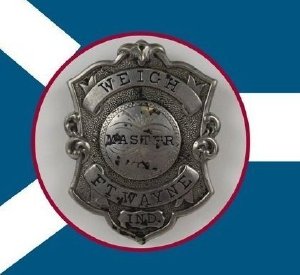From the original platting of Fort Wayne to the development of modern services, local government has been an integral part of the life of the community. In the early to mid 1800s as Fort Wayne's population increased, local government had to adapt and grow along with the community. These early services laid the groundwork to meet the ever-changing needs of residents throughout the nineteenth and twentieth centuries.
Allen County was created on 1 April 1824 by an act of the Indiana legislature on 17 December 1823 and Fort Wayne was selected to be the seat of Allen County government. On 22 May, the first election of county officers was held and on 26 May, the newly-elected board of county commissioners met at the house of Alexander Ewing for a six-day organizational session.
Volunteer firefighting services were established in the 1830s in recognition of the need for protection only a community working together can provide. During the 1830s it also became apparent that the city would benefit from a central location for commerce, and the city market was established.
In 1840 the Indiana state legislature approved a charter for Fort Wayne's incorporation as a city, and with the charter came our first formal government and the election of the first mayor of Fort Wayne, George W. Wood. Local citizens voted in the first nine mayoral elections using the same secure ballot box from 1840-1856. With new authority to tax for civil improvements, the city's first public utilities project was completed in 1858.
Since 1832, four county courthouses have housed Allen County courts and governmental offices. As county needs grew, so did the courthouses, from a small structure, located between Calhoun and Court Streets to the beautiful Allen County Courthouse dedicated in 1902 that is still in use today.
In 1892 Mayor Charles Zollinger's administration commissioned the construction of a City Building. Dedicated the following year on 20 April 1893, the City Building at the southeast corner of Berry and Barr Streets would be home to Fort Wayne government, including departmental offices, the City Council, City Court, the police department and calaboose until 1971. The Allen County-Fort Wayne Historical Society moved their museum from the Swinney House and opened a new museum in the Old City Hall in October 1980.
Today, the community continues to thrive through its leadership. The services provided contribute to the high quality of life residents enjoy, making it very clear why Allen County is such a great place to work, play and live.
Be sure to visit our virtual exhibit page again in November to view the next installment of 200@200.
What is 200@200?
As Indiana embarked on its bicentennial anniversary and reflected on past challenges, successes, and opportunities, we too reflected on 200 years of our part of Indiana. How had Fort Wayne changed? What had we discovered? What would we take with us into the next century?
The 200@200 project was a celebration of Fort Wayne's legacy of progress throughout Indiana's 200 years of history. Using artifacts from the museum's collection of 28,000 objects, the History Center told 200 unique stories of Fort Wayne's role in the 200 years of Indiana's statehood throughout the 2016 bicentennial year. Each month highlighted a different historical theme and presented a collective mosaic of the community's shared past and present, commemorating the progress, growth, and creativity of the "Summit City." Each month's theme was featured in a virtual exhibit and in person at the History Center.
The History Center was honored to share that 200@200 had been endorsed by the Indiana Bicentennial Commission as an official Legacy Project. WANE served as the project's media sponsor.

